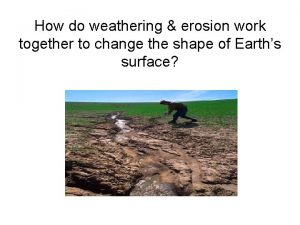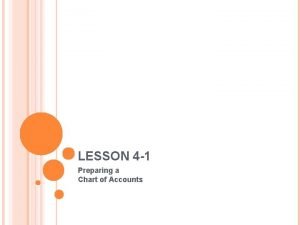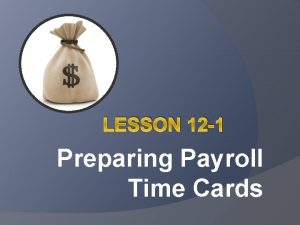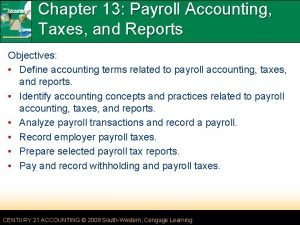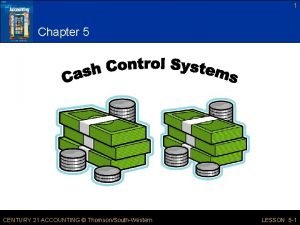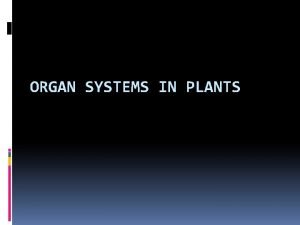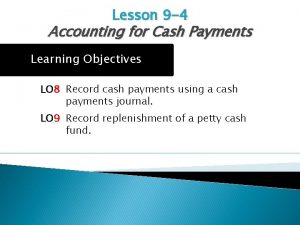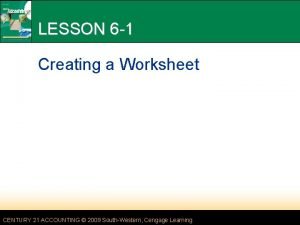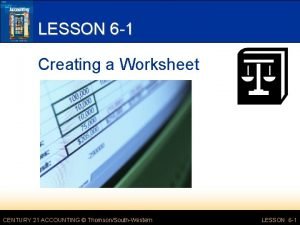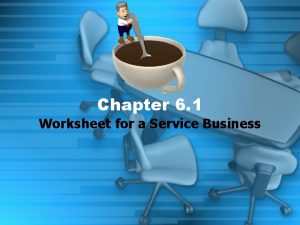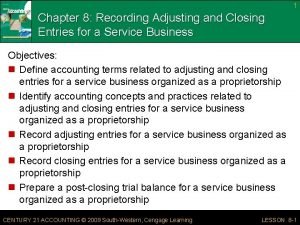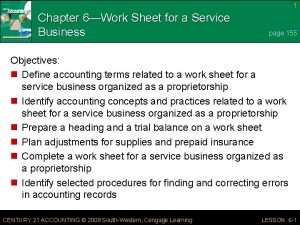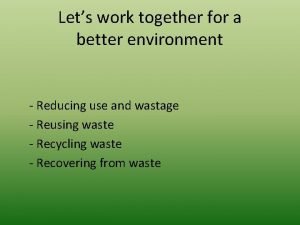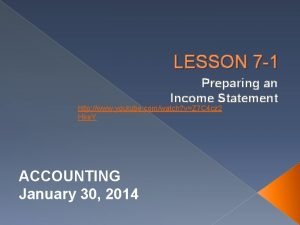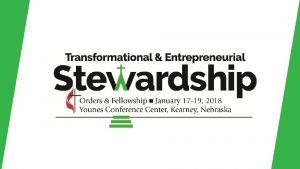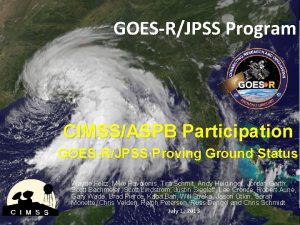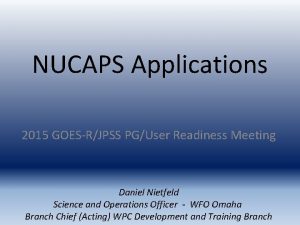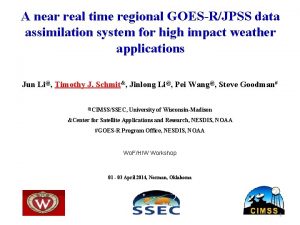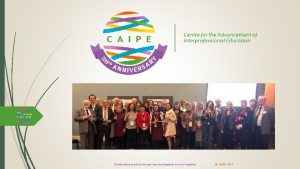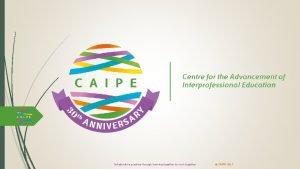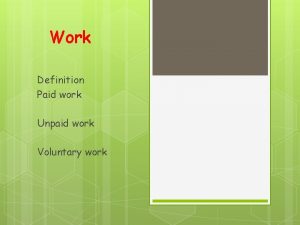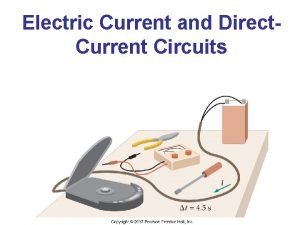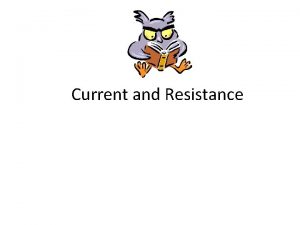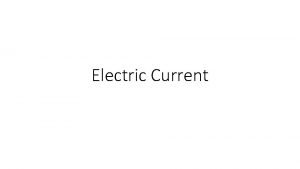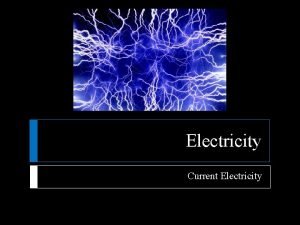How will GOESRJPSS and current GOESSNPP work together






































- Slides: 38

How will GOES-R/JPSS and current GOES/SNPP work together? Jason Taylor – User Services Coordinator Satellite Products and Services Division (SPSD) NESDIS/Office of Satellite and Product Operations (OSPO) NOAA Satellite Proving Ground/User Readiness Meeting Session 3: Satellite CONOPS May 9 -13, 2016 Norman, OK

Presentation Contributors NESDIS / OSPO / SPSD @ NCWCP • • • Matt Seybold, GOES-R Data Ops Manager John Paquette, Physical Scientist Shuang Qiu, Suomi NPP Product Area Lead (PAL) Limin Zhao, Satellite Products Branch Antonio Irving, Chief - Satellite Products Branch Thomas Renkevens – Chief – SPSD Division Jay Hanna – Satellite Analysis Branch Jamie Kibler - Satellite Analysis Branch Natalia Donoho – User Services Coordinator Kathryn Miretzky – GOES-R User Services National Center for Weather & Climate Prediction (NCWCP) NESDIS / OSPO / MOD @ NSOF • • • Donna Mc. Namara, Data Access Manager Chris Sisko, JPSS Data Operations Manager Carl Gliniak, Acting POES Lead John Tsui, GOES Lead Kevin Ludlum, GOES/DSCOVR Scheduling Team Lead NOAA Satellite Operations Facility (NSOF) 2

Presentation Outline • Overview of the Office of Product and Satellite Operations (OSPO) • Status of Satellite Operations – GOES & POES • Current and Future Data Access and Distribution – User Subscription Revalidation • • • GOES-NOP & GOES-R Concurrent Operations SAB Preparations for GOES-R data S-NPP & JPSS-1 Concurrent Operations Development Initiatives, Products & Other Hot Topics Q&A 3

NESDIS Office of Satellite and Product Operations (OSPO) • Operates the Nation’s 16 environmental satellites: 3 Geostationary (GOES) by NOAA 3 Polar-Orbiting (POES) by NOAA 6 Defense Meteorological Satellite program (DMSP) operated by NOAA 2 OSTM Jason-2 & Jason-3 (Ocean Surface Topography Mission) - Joint NOAA, NASA, CNES, EUMETSAT effort – 1 Suomi National Polar-orbiting Partnership (NPP) by NOAA & NASA – 1 DSCOVR (Deep Space Climate Observatory) by NOAA – – 4

OSPO’s Key Roles • Ground System Command & Control, Ingest, Generation, and Distribution • Pre-Launch and Post-Launch Testing • Operational Testing, Validation, and Verification • User Readiness for Broadcast Services and Product Delivery • Long-Term Continuity of Products and Services 5

Satellite Operations, Processing and Distribution SNPP/JPSS-1 (PM) POES NOAA-19 GOES-West GOES-East Non-NOAA (Jason 2, DMSP, Meteosat, Himawari, Metop, EOS, COSMIC, others) Center for Satellite Applications and Research (STAR) Product Development Algorithm Development Science Maintenance Office of Satellite and Product Operations (OSPO) METOP-B/C (AM) TDRSS Fairbanks Wallops Svalbard Mc. Murdo / Troll Command Control Processing and Distribution Satellite Operations Control Center Environmental Satellite Processing Center Office of Satellite Ground Services (OSGS) Ground Systems Development and Sustainment, IT Enterprise Architecture Suitland Customers Data and Products Archive and Access NESDIS Data Centers 6

Satellite Direct Service Operations Emergency Managers Weather Information Network (EMWIN): • NOAA satellites relay critical information to users across the country. http: //www. weather. gov/emwin/index. htm Low Resolution Image Transmission (LRIT): • NOAA satellites are used to relay satellite and weather products to users in remote locations, that do not have landlines or internet connections. http: //www. noaasis. noaa. gov/LRIT/ Data Collection: • NOAA satellites are used to collect and relay scientific data from around the globe. http: //www. noaasis. noaa. gov/DCS/ http: //www. noaasis. noaa. gov/ARGOS/ Search and Rescue Satellite Aid Tracking (SARSAT): • NOAA satellites are used to relay distress alerts from aviators, mariners and land-based users (250 rescued through calendar year of 2015). http: //www. sarsat. noaa. gov/ Geonetcast Americas: • Data from NOAA for diverse societal benefits - agriculture, energy, health, climate, weather, disaster mitigation, biodiversity, water resources, and ecosystems. http: //www. geonetcastamericas. noaa. gov/index. html 7

OSPO’s Satellite Products and Services Division • Provides 24 x 7 interpretive analyses of satellite data - Atmospheric temp/moisture Hurricane intensity & position Volcanic Ash Fire and Smoke Oil Spills Significant Precipitation (20 x 7) • Manages automated environmental products • Collaborates with partners to support transition of research products into operations 8

Status of Satellite Operations 9

GOES Status (Apr 27, 2016) Key Operational G Spacecraft issues but no user impacts S/C Operational with limitations Y Non-operational R http: //www. oso. noaa. gov/goesstatus 10

GOES Flyout Schedule http: //www. nesdis. noaa. gov/Flyout. Schedules. html http: //www. goes-r. gov 11

POES Status (Apr 26, 2016) http: //www. ospo. noaa. gov/Operations/POES/status. html Operational Spacecraft Issue but no User Impact G S/C Operational with Limitation Y Non-Operational R Not Applicable N/A 12

S-NPP Status as of April 2016 Spacecraft Launch Date Mission Category S-NPP Payload Instruments Status Spacecraft Subsystem Status Oct 28, 2011 ATMS G TLM, Command & Control G LTAN 1330 (PM) +/- 10 mins CERES G ADCS G Cr. IS G EPS G OMPS – Nadir G Thermal Control G OMPS – Limb G Communications G VIIRS G CDP G SCC G Operational (or capable of) GPS G Operational with limitations (or in standby) 1553 G 1394 G Operational with degraded performance Functional but turned off Not functional No status reported 13

LEO Flyout Schedule http: //www. nesdis. noaa. gov/Flyout. Schedules. html http: //www. jpss. noaa. gov 14

Current and Future Data Access & Distribution 15

Data Access & Distribution Policy • Full policy and forms at http: //www. ospo. noaa. gov/Organization/About/access. html • Security requirement to know and document all users accessing operational data servers and what products they are receiving – Users request data using a Data Access Request (DAR) form. • Ever increasing data volume requires prioritization of users to effectively manage distribution resources and ensure effective system performance • Higher priority access will be given to organizations with: – Mission and statutory authority – Signed NESDIS cooperative agreements or legislative authorities – A demonstrated timeliness requirement for near-real time data to support operational user applications • If available and sufficient, users will be directed to sources of data external to NESDIS (e. g. CIMSS). Also recommend alternatives for denied users Cloud Top Pressure Lifted Index 16

PDA Distribution Service Improvements • The purpose of the Product Distribution and Access (PDA) is to serve as the NESDIS enterprise distribution system for near real-time users. – PDA will enable NESDIS to more easily scale framework to meet future distribution demands. – Provide for enhanced security controls / transfer protocols. – Allow for far greater management control and system insight over data distribution. – Grant the ability to deliver the large mission data (such as GOES-R, JPSS, etc) to authorized users. – In deference to NOAA security policies, PDA will set subscriptions for international and non-US government partners, as is done now on the DDS. (PDA User Interface requires a government CAC or PIV card. ) 17

Data Access & Distribution in PDA Era • Legacy GOES data in GVAR format will be on PDA. • Mc. IDAS AREA files will remain on Geo. Dist servers for GOES 13 & 15. • Users will need to obtain GOES-R data via PDA. • GOES-R data will not be on Geo. Dist servers and will not be in Mc. IDAS AREA file format nor served on ADDE. • Newer versions of Mc. IDAS will allow users to read GOES-R data. • S-NPP/JPSS products will be generated by NDE 2. 0 and provided via PDA. • All distribution will use FTPS or SFTP protocols. 18

User Subscription Revalidation • All users will be asked to revalidate their subscriptions before the switch to PDA occurs. o Notification will likely go out in June with an August deadline. • Users will need to complete and submit the new Data Access Request (DAR) form (Apr. 2016 version 15). o Exception for users involved with Soleres integration activities. • Subscribers who fail to revalidate will not be automatically moved over to PDA or removed from DDS. o As data gets moved off DDS and the DDS is subsequently turned off, users who do not revalidate will be without data. 19

ESPC Data Access Request Form http: //www. ospo. noaa. gov/Organization/Documents/Word/ESPCData. Access. Request. Form-Apr 2016. docx 20

GOES-NOP & GOES-R Concurrent Operations at OSPO 21

GOES-NOP & GOES-R Operations • After launch, OSPO plans to maintain current GOES constellation until a decision is made regarding GOES-R positioning. o OSPO will continue to keep a standby satellite at 105 w as backup to GOES-East and GOES-West. • GOES-R will have no effect on how OSPO manages current operational satellites (GOES-13 & 15). o GOES maintenance schedules (i. e. planned maneuvers) will continue to be executed. 22

GOES-NOP & GOES-R Operations • The continuance of GOES-14 SRSOR is not envisioned. o Depends on user requests and our ability to provide support. o When not performing SRSOR schedules and needed maneuvers, this satellite will remain in standby. • GOES-R will likely move to either the East or West position in October 2017. o Two spare GOES satellites will likely exist as a result unless a decision is made otherwise. • The decision on positioning of GOES-R will depend on: o The overall health of the entire GOES constellation and the needs of the user community. 23

SAB Preparations for GOES-R • Proposal for SAB operations includes primary and backup GOES-R servers at both NCWCP and NSOF. • One pull will be performed from the PDA to the primary NCWCP and NSOF GOES-R servers and rsyncs will be performed to each of the backups. • Only two group accounts will access PDA and all SAB workstations will be able to access these servers without exceeding the PDA pull limits. • Target completion in time to allow SAB to evaluate GOES-R data by January 2017. 24

SNPP & JPSS-1 Concurrent Operations at OSPO 25

SNPP & JPSS-1 Operations • The JPSS-1 mission profile is substantially similar to SNPP as JPSS-1 will lead S-NPP by ½ orbit (i. e. ~51 min. ) • With the launch of JPSS-1, NOAA will operate two satellites within the same environment. • S-NPP northern contact will often coincide with JPSS-1 southern contact. • JPSS 1 - SMD playback data latency significantly improved vs. S-NPP( 140 to 80 min. ) • The Community Satellite Processing Package (CSPP) supports direct readout users in making the transition from POES to SNPP and subsequently to JPSS. 26

Development Initiatives, Products & Other Hot Topics 27

S-NPP Near-Constant Contrast NWS Technical Implementation Notice 15 -48 issued on Oct 20, 2015 http: //www. nws. noaa. gov/os/notification/tin 15 -48 nde_npp_sbn. htm • • • On December 14, 2015 at 1500 UTC, NESDIS began sending S-NPP Near-Constant Contrast (NCC) imagery to the NWS NCF for further broadcast via the Satellite Broadcast Network (SBN) to support NWS AWIPS. NCC products provide improved environmental sensing and user analyses in extreme low light conditions. The new imagery is provided to four geographical regions: - Alaska Region Sector (WMO Header: TIPB 10 KNES) Pacific Region Sector (WMO Header: TIPI 10 KNES) CONUS Sector (WMO Header: TIPC 10 KNES) Puerto Rico Sector (WMO Header: TIPQ 10 KNES) Example of NCC in AWIPS 2/CAVE Alaska Region Sector. 28

GOES-East Imager ASOS SCP for CONUS • On December 29, 2015, the GOES-East Imager ASOS SCP products for CONUS were operationally implemented as a replacement for the GOES-East Sounder ASOS SCP products. • This action was in response to the loss of IR sounder data from the GOES-East (GOES-13) Sounder instrument failure on November 20, 2015. • The GOES-East Imager ASOS SCP products may not be able to produce for all the stations that were produced by the GOESEast Sounder ASOS SCP due to a different coverage of Imager and Sounder for CONUS regions. 29

New GOES Ingest NOAAPORT Interface GINI-II – Benefits for AWIPS • Improved Reliability – Quicker fault detection (missing scan lines, frame breaks, etc. ) – More efficient fault diagnosis and resolution • Improved Processing Efficiency – Faster production and distribution • Overall timeliness improvement • Increase in Visible Imagery – Production of visible imagery periods now dependent on location of AWIPS sector, not a universal time period for all sectors 30

POES AVHRR Channel Switching • Background: AVHRR Channel 3 A/3 B – Hydrology Community needs snow/ice data mapping (channel 3 A). – Hazard Community needs data for fire detection and monitoring (channel 3 B). • Traditional configuration: – POES AVHRR using 3 B, NOAA-15, NOAA-18 and NOAA-19 – Metop AVHRR 3 A/3 B configuration: both A and B swapping at day/night terminator crossing • Origin of initial request for switching and justification came from Geographic Information Network of Alaska (GINA). • NESDIS granted formal NWS request for the activation of 3 A/3 B switching of NOAA-15 and NOAA-19 satellites to Channel 3 A over the Alaska region for the period excluding May 15 th to Sept. 15 th. 31

Satellite Products – Transitioned to Operations Product Name Date Status Global Mosaic of Geostationary Satellite Imagery (GMGSI) GCOM-W 1 and AMSR-2 Day-1 Products Himawari-8 in 5 km Blended SST Analysis Blended-Hydro Products with AMSR-2 Capability GOES Evapotranspiration and Drought Product System (GET-D) Ocean Heat Content Suite inclusion of Cryosat-2 Sea Surface Height Anomalies Nov 2015 Operational Jan 2016 Operational March 2016 Operational April 2016 Operational 32

GMGSI – Operational • Global Mosaic of Geostationary Satellite Imagery (GMGSI) was activated by OSPO in November 2015. – Generates 8 -km global composite dataset (longwave IR, shortwave IR, and visible) with coverage extended to 60°S latitude. – Provides global satellite data to help Environmental Modeling Center (EMC) derive new global icing analysis products for the improvement of international flight safety. http: //www. ospo. noaa. gov/Products/imagery/gmgsi-sw-ir. html 33

GCOM-W 1 AMSR-2 Day 1 Products – Operational • The Global Change Observation Mission - GCOM-W 1 Advanced Microwave Scanning Radiometer 2 (AMSR 2) Day 1 Products were activated by OSPO in November 2015. – Implementation includes AMSR-2 Imagery, Total Precipitable Water (TPW), Cloud Liquid Water, Rain Rate, Sea Surface Temperature, and Sea Surface Wind Speed. – Improves numerical weather prediction, precipitation and tropical cyclone location, intensity analysis, and monitoring. Total Precipitable Water Sea Surface Wind Speed http: //www. ospo. noaa. gov/Products/atmosphere/gpds/ 34

Blended-Hydro Products with GCOM-W 1 Capability– Operational • March 30, 2016 - The newly added GCOM-W 1 capability, will led to improvements in data quality, temporal refresh rate, and spatial coverage. http: //www. ospo. noaa. gov/Products/ocean_heat. html 35

Ocean Heat Content Suite inclusion of Cryosat-2 Sea Surface Height Anomalies – Operational • As of April 12, 2016, Satellite Ocean Heat Content (OHC) Suite of products are using Cryosat-2 Sea Surface Height Anomalies as input in addition to Jason-2 and SARAL/Alt. Ka Sea Surface Height Anomalies. – Sea surface height anomalies (SSHAs) derived from altimeters on multiple satellites are crucial to the computation of satellite derived ocean heat content. http: //www. ospo. noaa. gov/Products/ocean_heat. html 36

ESPC Notifications, Status, and Contacts 24/7 Help Desk ESPCOperations@noaa. gov ESPC Messages http: //www. ssd. noaa. gov/PS/SATS/messages. html WMO GTS Bulletins Urgent: http: //www. weather. gov/view/valid. Prods. php? prod=ADM&node=KNES Routine: http: //www. weather. gov/view/valid. Prods. php? prod=ADA&node=KNES User Services SPSD. User. Services@noaa. gov Data Access NESDIS. Data. Access@noaa. gov Webmaster SSDWebmaster@noaa. gov Facebook www. facebook. com/NOAANESDIS Twitter www. twitter. com/noaasatellites Satellite Ops Status http: //www. oso. noaa. gov/daily-news/index. asp Press releases http: //www. nesdis. noaa. gov/news_archives/ Web www. ospo. noaa. gov 37

Thank you! Questions? 38
 Y connected generator
Y connected generator Phase to phase voltage
Phase to phase voltage N=nc exp(-eg/2kt)
N=nc exp(-eg/2kt) Line current and phase current
Line current and phase current Drift current
Drift current Drift current and diffusion current
Drift current and diffusion current In a delta connected source feeding a y connected load
In a delta connected source feeding a y connected load Holding current and latching current
Holding current and latching current Drift current and diffusion current in semiconductor
Drift current and diffusion current in semiconductor Vragen
Vragen Q point
Q point Why must the electrode holder be correctly sized
Why must the electrode holder be correctly sized Touch current vs leakage current
Touch current vs leakage current Kcl mesh analysis
Kcl mesh analysis How does the sun moon and earth work together
How does the sun moon and earth work together Circulatory system and respiratory system work together
Circulatory system and respiratory system work together Dust bowl 1930s
Dust bowl 1930s How does the sun moon and earth work together
How does the sun moon and earth work together Chapter 4 section 1 work and machines answer key
Chapter 4 section 1 work and machines answer key 4-1 work together p. 97
4-1 work together p. 97 Study guide 12 part two analyzing payroll procedures
Study guide 12 part two analyzing payroll procedures Application problem 13-2 accounting
Application problem 13-2 accounting Century 21 accounting chapter 5 study guide answers
Century 21 accounting chapter 5 study guide answers The more we work together
The more we work together A group of organs working together
A group of organs working together 9-4 accounting answers
9-4 accounting answers 1. 6-1 work together, p. 162
1. 6-1 work together, p. 162 6-1 work together p. 162 answers
6-1 work together p. 162 answers What is written on the three-line heading on a work sheet?
What is written on the three-line heading on a work sheet? Chapter 8 recording adjusting and closing entries
Chapter 8 recording adjusting and closing entries 6-4 work together p. 170
6-4 work together p. 170 Cells working together form
Cells working together form Let's work together for a better future
Let's work together for a better future 7-1 work together p. 186 answers
7-1 work together p. 186 answers Smart work and hard work
Smart work and hard work Work energy theorem
Work energy theorem If you believe and i believe
If you believe and i believe Work immersion ethics
Work immersion ethics Objective in immersion
Objective in immersion
















